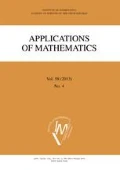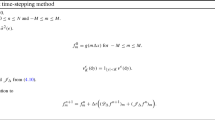Abstract
In this paper we are concerned with finite element approximations to the evaluation of American options. First, following W. Allegretto etc., SIAM J. Numer. Anal. 39 (2001), 834–857, we introduce a novel practical approach to the discussed problem, which involves the exact reformulation of the original problem and the implementation of the numerical solution over a very small region so that this algorithm is very rapid and highly accurate. Secondly by means of a superapproximation and interpolation postprocessing analysis technique, we present sharp L 2-, L ∞-norm error estimates and an H 1-norm superconvergence estimate for this finite element method. As a by-product, the global superconvergence result can be used to generate an efficient a posteriori error estimator.
Similar content being viewed by others
References
W. Allegretto, G. Barone-Adesi, E. Dinenis, Y. Lin, G. Sorwar: A new approach to check the free boundary of single factor interest rate put option. Finance 20 (1999), 153–168.
W. Allegretto, G. Barone-Adesi, R. J. Elliott: Numerical evaluation of the critical price and American options. European J. Finance 1 (1995), 69–78.
W. Allegretto, Y. Lin, H. Yang: Finite element error estimates for a nonlocal problem in American option valuation. SIAM J. Numer. Anal. 39 (2001), 834–857.
W. Allegretto, Y. Lin, H. Yang: A fast and highly accurate numerical method for the evaluation of American options. Dyn. Contin. Discrete Impuls. Syst., Ser. B Appl. Algorithms 8 (2001), 127–138.
L. Badea, J. Wang: A new formulation for the valuation of American options. I. Solution uniqueness. II. Solution existence. Anal. Sci. Comput. (Eun-Jae Park, Jongwoo Lee, eds.) 5 (2000), 3–16, 17–33.
G. Barone-Adesi, R. E. Whaley: Efficient analytic approximation of American option values. J. Finance 42 (1987), 301–320.
F. Black, M. Scholes: The pricing of options and corporate liabilities. J. Polit. Econ. 81 (1973), 637–659.
P. Boyle, M. Broadie, P. Glasserman: Monte Carlo methods for security pricing. J. Econ. Dyn. Control 21 (1997), 1267–1321.
M. J. Brennan, E. S. Schwartz: The valuation of American put options. J. Finance 32 (1997), 449–462.
M. Broadie, J. Detemple: American option valuation: New bounds, approximations, and a comparison of existing methods. Rev. Financial Studies 9 (1996), 1211–1250.
J. Crank: Free and Moving Boundary Problems. Clarendon Press, Oxford, 1984.
D. J. Duffy: Finite Difference Methods in Financial Engineering: A Partial Differential Equation Approach. John Wiley & Sons, Hoboken, 2006.
B. C. Eaves: On the basic theorem of complementarity. Math. Program. 1 (1971), 68–75.
C. M. Elliott, J. R. Ockendon: Weak and Variational Methods for Moving Boundary Problems. Pitman, Boston-London-Melbourne, 1982.
A. Fetter: L ∞-error estimate for an approximation of a parabolic variational inequality. Numer. Math. 50 (1987), 557–565.
M. Feistauer: On the finite element approximation of functions with noninteger derivatives. Numer. Funct. Anal. Optimization 10 (1989), 91–110.
W. Han, X. Chen: An Introduction to Variational Inequalities: Elementary Theory, Numerical Analysis and Applications. Higher Education Press, Beijing, 2007.
J. Huang, M.C. Subrahmanyam, G.G. Yu: Pricing and hedging American options: A recursive integration method. Rev. Financial Studies 9 (1996), 277–300.
J. Hull: Option, Futures and Other Derivative Securities, 2nd edition. Prentice Hall, New Jersey, 1993.
P. Jaillet, D. Lamberton, B. Lapeyre: Variational inequalities and the pricing of American options. Acta Appl. Math. 21 (1990), 263–289.
L. Jiang, M. Dai: Convergence of binomial tree methods for European/American path-dependent options. SIAM J. Numer. Anal. 42 (2004), 1094–1109.
L. Jiang, M. Dai: Convergence of the explicit difference scheme and binomial tree method for American options. J. Comput. Math. 22 (2004), 371–380.
L. Jiang: Mathematical Modeling and Methods of Options Pricing. Higher Education Press, Beijing, 2003.
H. E. Johnson: An analytic approximation for the American put price. J. Financial and Quantitative Anal. 18 (1983), 141–148.
M. Křížek, P. Neittaanmäki: Bibliography on superconvergence. In: Proc. Conf. Finite Element Methods: Superconvergence, Post-processing and A Posteriori Estimates, Lecture Notes in Pure and Appl. Math. 196 (M. Křížek et al., ed.). Marcel Dekker, New York, 1998, pp. 315–348.
Y. K. Kwok: Mathematical Models of Financial Derivatives. Springer, Singapore, 1998.
Q. Lin, N. Yan: The Construction and Analysis of High Efficiency Finite Element Methods. Hebei University Publishers, Baoding, 1996. (In Chinese.)
Q. Lin, S. Zhang: An immediate analysis for global superconvergence for integrodifferential equations. Appl. Math. 42 (1997), 1–21.
M. Liu, J. Wang: Pricing American options by domain decomposition methods. In: Iterative Methods in Scientific Computation (J. Wang, H. Allen, H. Chen, L. Mathew, eds.). IMACS Publication, 1998.
T. Liu, P. Zhang: Numerical methods for option pricing problems. J. Syst. Sci. & Math. Sci. 12 (2003), 12–20.
M. D. Marcozzi: On the approximation of optimal stopping problems with application to financial mathematics. SIAM J. Sci. Comput. 22 (2001), 1865–1884.
L. W. MacMillan: Analytic approximation for the American put option. Adv. in Futures and Options Res. 1 (1986), 1149–1159.
H. P. McKean: Appendix: A free boundary problem for the heat equation arising from a problem in mathematical economics. Industrial Management Rev. 6 (1965), 32–39.
R. C. Merton: Theory of rational option pricing. Bell J. Econom. and Management Sci. 4 (1973), 141–183.
A. M. Sanchez, R. Arcangéli: Estimations des erreurs de meilleure approximation polynomiale et d’interpolation de Lagrange dans les espaces de Sobolev d’ordre non entier. Numer. Math. 45 (1984), 301–321. (In French.)
J. Topper: Financial Engineering with Finite Elements. John Wiley & Sons, Hoboken, 2005.
R. Underwood, J. Wang: An integral representation and computation for the solution of American options. Nonlinear. Anal., Real World Appl. 3 (2002), 259–274.
C. Vuik: An L 2-error estimate for an approximation of the solution of a parabolic variational inequality. Numer. Math. 57 (1990), 453–471.
P. Wilmott, J. Dewynne, S. Howison: Option Pricing: Mathematical Models and Computation. Financial Press, Oxford, 1995.
T. Zhang: The numerical methods for American options pricing. Acta Math. Appl. Sin. 25 (2002), 113–122.
Author information
Authors and Affiliations
Corresponding author
Additional information
Dedicated to Ivan Hlaváček on the occasion of his 75th birthday
This work was supported in part by the National Natural Science Foundation of China (10471103 and 10771158), the National Basic Research Program (2007CB814906), Social Science Foundation of the Ministry of Education of China (Numerical Methods for Convertible Bonds, 06JA630047), Tianjin Natural Science Foundation (07JCY-BJC14300), and Tianjin University of Finance and Economics.
Rights and permissions
About this article
Cite this article
Lin, Q., Liu, T. & Zhang, S. Superconvergence estimates of finite element methods for American options. Appl Math 54, 181–202 (2009). https://doi.org/10.1007/s10492-009-0012-x
Published:
Issue Date:
DOI: https://doi.org/10.1007/s10492-009-0012-x
Keywords
- American options
- variational inequality
- finite element methods
- optimal and superconvergent estimates
- interpolation postprocessing
- a posteriori error estimators




